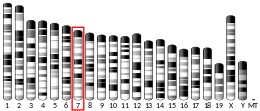
Epiregulin (EPR) is a protein that in humans is encoded by the EREG gene.

Glucosidase 2 subunit beta is an enzyme that in humans is encoded by the PRKCSH gene.

Macrophage-stimulating protein (MSP), also known as hepatocyte growth factor-like protein, is a protein that in humans is encoded by the MST1 gene.

Interleukin 11 receptor, alpha subunit is a subunit of the interleukin 11 receptor. IL11RA is its human gene.

Deleted in azoospermia protein 2 is a protein that in humans is encoded by the DAZ2 gene.

NACHT, LRR and PYD domains-containing protein 7 is a protein that in humans is encoded by the NLRP7 gene.

Homeobox protein Hox-D1 is a protein that in humans is encoded by the HOXD1 gene.

Proto-oncogene serine/threonine-protein kinase mos is an enzyme that in humans is encoded by the MOS gene.

Centriolin is a protein that in humans is encoded by the CNTRL gene. It was previously known as CEP110.

Protein POF1B is a protein that in humans is encoded by the POF1B gene.

Disintegrin and metalloproteinase domain-containing protein 18 is an enzyme that in humans is encoded by the ADAM18 gene.

Bardet–Biedl syndrome 9 is a protein that in humans is encoded by the BBS9 gene.

CatSper1, is a protein which in humans is encoded by the CATSPER1 gene. CatSper1 is a member of the cation channels of sperm family of protein. The four proteins in this family together form a Ca2+-permeant ion channel specific essential for the correct function of sperm cells.

NLRP6, short for NOD-like receptor family pyrin domain containing 6, is an intracellular protein that plays a role in the immune system. It is also known as NALP6, PYPAF5, PAN3, and CLR11.4, and is one of 14 pyrin domain containing members of the NOD-like receptor family of pattern recognition receptors. As with several other NOD-like receptors, NLRP6's role in immunity is related to its ability to regulate caspase-1 and NF-κB activity.

NLRP8, short for NOD-like receptor family pyrin domain containing 8, is an intracellular protein that is expressed in the ovaries, testes, and preimplantation embryos of mammals. It is also known as NALP8, NOD16, PAN4, and CLR19.2, and is one of 14 pyrin domain containing members of the NOD-like receptor family of cytoplasmic receptors.

NLRP9, short for NOD-like receptor family pyrin domain containing 9, is an intracellular protein that is expressed in the ovaries, testes, oocytes, and preimplantation embryos of mammals that is likely involved in reproductive processes. It is also known as NALP9, NOD6, PAN12, and CLR19.1, and is one of 14 pyrin domain containing members of the NOD-like receptor family of cytoplasmic receptors.

NLRP10, short for NOD-like receptor family pyrin domain containing 10, is an intracellular protein of mammals that functions in apoptosis and the immune system. It is also known as NALP10, NOD8, PAN5, Pynod, and CLR11.1, and is one of 14 pyrin domain containing members of the NOD-like receptor family of cytoplasmic receptors, although it differs from other NOD-like receptors by lacking the characteristic leucine-rich repeat domain. It is also believed that it helps regulate the inflammatory response. NLRP10 reduces inflammatory and innate immune responses by inhibiting the activity of two proteins associated with the inflammasome; caspase-1 and PYCARD.

NOD-like receptor family pyrin domain containing 11 is a protein that in humans is encoded by the NLRP11 gene located on the long arm of human chromosome 19q13.42. NLRP11 belongs to the NALP subfamily, part of a large subfamily of caterpiller. It is also known as NALP11, PYPAF6, NOD17, PAN10, and CLR19.6

NLRP13, short for NOD-like receptor family pyrin domain containing 13, is an intracellular protein of mammals. It is also known as NALP13, NOD14, PAN13, and CLR19.7, and is one of 14 pyrin domain containing members of the NOD-like receptor family of cytoplasmic receptors. The function of NLRP13 is currently unknown.

NLRP14, short for NOD-like receptor family pyrin domain containing 14, is an intracellular protein of mammals associated with a role in spermatogenesis. It is also known as NALP14, NOD5, GC-LRR, Nalp-iota, PAN8, and CLR11.2, and is one of 14 pyrin domain containing members of the NOD-like receptor family of cytoplasmic receptors. NLRP14 is found exclusively in the testes where it is expressed within spermatogonia, spermatocytes and spermatids.













